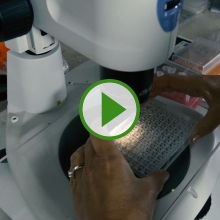Getting to the gut of ALS
Briefs

ALS, also known as Lou Gehrig’s disease, is characterized by the brain’s failure to transmit messages to the muscles, causing rapid muscle atrophy and leading to paralysis, respiratory failure, and eventually, death. Until recently, scientists studying ALS usually focused their attention on the brain, believing it held the key to unlocking the mysteries of this neurodegenerative disorder.
A Weizmann team led by Prof. Eran Elinav of the Department of Immunology and Prof. Eran Segal of both the Department of Molecular Cell Biology and the Department of Computer Science and Applied Mathematics, started looking for answers in the gut, conducting experiments to see if they could learn how intestinal microbes affected the health of the brain. They recently made a discovery, published in Nature in July, where they successfully altered the progression of the disease in mouse models after administering certain strains of gut microbes.
Upon finding that symptoms of ALS in mice worsened when given broad-spectrum antibiotics that destroyed a significant portion of their microbiome, the scientists set out to identify the parts of the gut that were responsible. When comparing the microbiome of ALS-prone mice to that of healthy mice, the team pinpointed 11 microbial strains that were defective in the diseased models.
They proceeded to isolate and administer each strain individually, and found that one, Akkermansia muciniphila, considerably hindered disease progression and prolonged survival. They noticed that the levels of a particular molecule called nicotinamide (NAM), which is secreted by Akkermansia, dropped precipitously following antibiotic treatment. When they started ALS-prone mice on a regimen of regular NAM infusions, the progression of ALS actually slowed.
Armed with these new findings, Profs. Elinav and Segal moved to a preliminary small-scale observational human study and discovered a similar pattern: Many of the NAM-producing genes were suppressed in ALS patients and the levels of NAM were significantly reduced.
Though the research is still in its early stages, this could be the first step on the path to developing new, life-saving treatments for ALS patients.
Prof. Elinav supported by the Estate of Myron H. Ackerman, Adelis Foundation, Estate of Bernard Bishin for the WIS-Clalit Program, Leona M. and Harry B. Helmsley Charitable Trust, Else Kroener Fresenius Foundation, Howard and Nancy Marks Charitable Fund, Lawrence and Sandra Post Family Foundation, Donald and Susan Schwarz, Yael and Rami Ungar, The Hanna and Dr. Ludwik Wallach Cancer Research Fund, European Research Council and he is the incumbent of the Sir Marc and Lady Tania Feldmann Professorial Chair.
Prof. Segal supported by Adelis Foundation, Judith Benattar, Crown Human Genome Center, Leona M. and Harry B. Helmsley Charitable Trust, Else Kroener Fresenius Foundation, Aliza Moussaieff, Fannie Sherr Fund, Estate of Zvia Zeroni, European Research Council.








